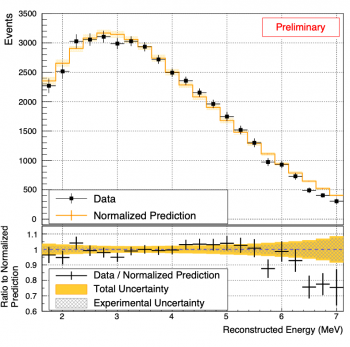The STEREO experiment releases new results based on the detection of about 65000 neutrinos at short distance from the research reactor of the ILL-Grenoble. The improved accuracy is rejecting the hypothesis of a 4th neutrino in a large fraction of the domain predicted from the reactor neutrino anomaly. Profiting from a good control of the detector response, STEREO now also releases its first absolute measurements of the neutrino rate and the spectrum shape.
Omnipresent particles, neutrinos are under scrutiny in all kinds of detectors to test the theory of the Standard Model, to witness the inside of reactors or stars, or to study the most violent and large-scale phenomena in the Universe. The detection of the faint signals left by the neutrinos has thus entered a high precision era, revealing new anomalies when comparing to expectations. The goal of the STEREO experiment is to perform a direct test of the existence of a hypothetical 4th neutrino, which could reconcile the so far unexplained deficit of neutrinos detected close to nuclear reactors (the reactor neutrino anomaly).
The STEREO detector is installed since end of 2016 at 10 m from the core of the reactor of the Institut Laue-Langevin (ILL) in Grenoble, France. It measures precisely the rates and energy spectra of the neutrinos emitted by the core in 6 identical detector cells. If a 4th neutrino exists, it will “oscillate” with the standard neutrinos, inducing a unique pattern of spectral distortions from one cell to another. However, the spectra measured in the 6 cells of the STEREO detector have compatible shapes and need a very careful analysis. The present result significantly shrinks the domain of existence of the 4th neutrino (Figure 1). As STEREO continues taking data it will improve its sensitivity and test the surviving zone, toward even smaller expected amplitudes of oscillations.

Figure 1: Exclusion contour drawn by the latest STEREO data in the plane of the amplitude of the oscillation toward an hypothetical 4th neutrino (horizontal axis) and the frequency of this oscillation (vertical axis). The blue area shows the expected exclusion coverage at the available statistical precision which would be obtained if all STEREO observables correspond exactly to the expectations without 4th neutrino. The red area is the actual exclusion contour based on the measured data resulting in statistical fluctuations around the blue limit. All points inside the red contour are excluded with at least 90% confidence level. This result rejects a large part of the domain of existence of the 4th neutrino predicted from the reactor neutrino anomaly (indicated by the black contours).

Figure 2: Ratio of the neutrino rate measured by STEREO to the expected rate (blue point). This new result is in good agreement with the previous set of measurements at reactors operating with a highly enriched nuclear fuel (black points and purple average). The new world average including the STEREO result is shown in red. An independent extraction of the 235U neutrino rate from the Daya Bay and Reno measurements at commercial reactors operating with mixed fuel is shown for comparison (green point).
Beyond the cell-to-cell comparison, a more difficult task is the control of the absolute response of the detector. The STEREO result is of great interest because the nuclear fuel of the ILL core is highly enriched and detected neutrinos originate from the fission of a unique isotope, 235U, instead of a mix of 4 fissioning isotopes at commercial reactors. The absolute rate and spectrum shape have been kept hidden in the STEREO analysis. They are “un-blinded” for the first time after defining the evaluation of all systematics and the analysis procedure. Figure 2 shows that STEREO is actually among the most precise measurements of the 235U fission neutrino rate, adding valuable accuracy in the test of the reactor neutrino anomaly. The spectrum shape as measured by the sum of the 6 cells shows a remarkable agreement with the predicted shape for a pure 235U spectrum up to 6.3 MeV, but deviations beyond the estimated uncertainties are also seen at the highest energies (Figure 3). STEREO has not expressed its full potential yet. Complementary calibration observables are under study to reduce further the shape uncertainties and as many neutrinos as already acquired are expected by until mid-2020!
STEREO is a French-German experiment devised and operated by a team of scientists from Irfu-CEA in Saclay, the Institut Laue-Langevin in Grenoble, the Annecy’s Particle Physics Laboratory (LAPP), the Grenoble’s Subatomic Physics and Cosmology Laboratory (LPSC) and the Max-Planck-Institut für Kernphysik in Heidelberg, Germany (MPIK).
Irfu is at the initiative of the STEREO project, designed and built the internal part of the detector, containing the 6 detector cells. Physicists are involved in many parts of the analysis, the detector energy response, the simulation of light collection, the prediction of neutrino rate and spectrum, and the statistical analysis of the measurements.
Contact




